» MY EXPERIENCE FOR BREEDING
TIPS FOR BREEDING SUCCESS
The following information are nothing but useful tips for success with this breed, due to the numerous requests from many fans who will battle it out for the first time with the hen with large tuft, even if everything seems so obvious; in fact this animal reserves some surprises that I learned to handle in the course of my experience.
Do not take this advice as absolute rules, but as a simple teachings that you might like to very useful in times of need.
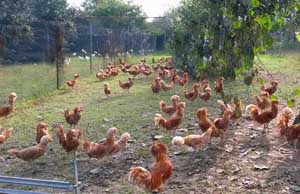
The selection of breeding
To have a good strain of Padua hens must begin with the subjects, adults already purchased or obtained from the egg or chick, which have the following minimum requirements: elegant posture with head held high, well developed tuft, absence or hint of a ridge, tarsi blue slate, plumage pure without the presence of feathers of other colors, strong constitution;the following year discarded females who started the suit before October-November, as there are definitely not good hens.
Always remember that you have to make good subjects from selected animals; also considering that it is a pure breed, then obtained for parental consanguinity and backcrosses, is less hardy and stronger than many other commercial hybrids created to have outstanding performance in all respects of view.
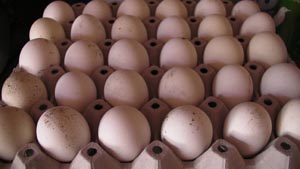
The eggs for incubation and hatching
The eggs incubate should be collected and kept in a cool location with the tip pointing down. While they may be dirty, hopefully not washe but brushed them. Non-incubated eggs of the current day, preferably let it sit a day, I put in my breeding incubating eggs stored for up to 7-8 days even if they can get to 10-12 days with a slight decline in the birth rate. The fertility is highly dependent on seasonal period: March to May-June reflected birth rates of 70-80%, while in the following months by 40-50%. For clients who come to take the eggs directly on the farm or purchased via shipment, I always suggest to keep them one day to rest and then incubate them. The systems of hatching are natural with the use of hen or artificial using the most different incubators. As far as incubators readjust to 37.7 ° C and then lower the temperature to 37.4 ° C the last three days before the birth, make sure that the relative humidity is close to 50% in the first days of hatching up to 60% to the time of hatching.
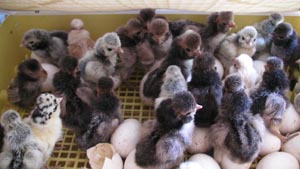
The management of the chicks
At birth there are no particular problems if you use a hen, while in the case of artificial hatching there are precautions to be observed; let dry chicks for about ten hours and without waiting for all born (in a couple of days at the most if the eggs were cool), remove dry ones and put them in a cage in a closed or repaired by air currents with a system of infrared heating (lamps) or with resistance.
Administered feed for chicks during the first period preferably with coccidiostat and water ad libitum, check several times during the day because in this period and until the age of three months, has the highest mortality rate.
A recommendation is important to prevent the spread of coccidiosis or other problems of the digestive system: avoid that animals are in direct contact with feces, so better use cages with mesh on the bottom to make sure that they are always in the best hygienic conditions.
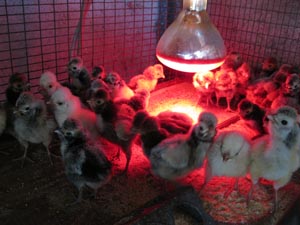
You can start from the first days a vaccination program for major diseases of chickens, even if successful tests done smoothly to wean the animals without resorting to vaccination: this applies, in particular, to farmers who, having a small number of heads, should incur a cost impractical for the purchase of vaccines.
Keep animals in cages or closed pens up to about three months before providing to free grazing, to avoid being preyed upon and damaged by pests (especially of the digestive tract), and continue to administer the feed with which you started the cycle. Do not change the first three months because I emphasize that the animals are in their most delicate moment.
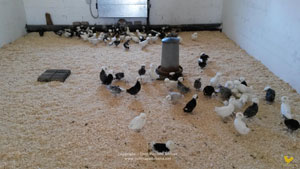
The chickens and sexing
At the age of about three months, you can begin to free or enlarge the animals, and gradually to change the diet and began to administer the broken corn and core commercial chickens. During this time you can already distinguish the sex of animals, observing the shape of the tuft (neat and compact with rounded tip pens in the female, the more messy, with narrow and more elongated pens in the male), and the color of the plumage (in the male is more shiny, especially in the area of the pens coverts of the tail).
At this age, males start a bit 'to fight each other and it is for this reason that animals should be expanded while maintaining the same leaders who, if grown up together, will not give you as big problems if you decide to enter into a new subject group already conformed, that would cause a break hierarchy.
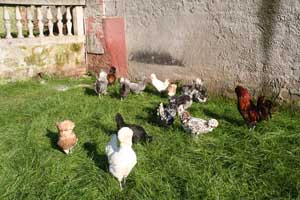
The adults
At 6- 7 months, the animals are adults, although the majesty of the plumage you will observe the following year after molting. By now, the chickens are rustic and strong enough to hold up well to diseases, especially of coccidiosis that can eradicate a young age in chickens. You can administer broken core corn for chickens and, in the period of egg production, specific foods that I will discuss in the next chapter. In addition, those wishing to be produced by mixing the feed raw materials available in the company, can safely proceed in this direction, which I do not recommend in the previous months.
The females begin to lay some eggs in the fall, if they are born in the spring, otherwise it will lay down the following year, in the month of March.
From this moment you can create groups of breeding (1 rooster and 8/10 hens), whereas if you want to keep the colors as well, the animals shall be divided by variety, otherwise you will get the different colors, the result of intersections of varieties as well.
Animal feeding
For simplicity, I divide based on the period the types of foods that I administer to my animals (nothing happens if the amount varied slightly):
- CHICKS: feed with coccidiostat first period up to three months
- PULLET: broken corn 60% - 40% core for chickens (The transition from corn to feed must be absolutely smooth)
- ADULTS: broken corn 60% - 40% core for chickens in winter broken corn 60% - core laying hens or pelleted feed hens 40% in egg production period (from February to September-October)
As mentioned before, it is possible to produce a feed from raw materials (I do not do), but attention to the amount of protein (18% - 22%) fundamentals, especially in the first six months after birth, the integration vitamins and minerals to prevent the occurrence of rickets or malnutrition that they may suffer these animals, as well as all races unlike the commercial crossings.
Admissions, facilities and equipment
I will not provide instructions structural or aesthetic, which are subjective characteristics that you need to personally evaluate and change anything on the success of your farm.
From the functional point of view, instead, the chicken coops must be fenced to a height of at least two meters, and, if in environments with several predators, in the lower part with the dual network to avoid that the chickens are attacked.
Of fundamental importance is the presence of an indoor area where the animals can repair itself, particularly in the days of strong heat or during the rainy season, as already described above, this breed is sensitive to moisture, as, possessing the large clump in cranial area, this can retain moisture for long periods and expose the animals to attacks by pests or diseases.
In this area you place the feeders covered, so that foods remain dry and do not develop mold and parasites, place the nests to lay their eggs (one every 3-4 hens), covered with straw or sand, and install the perches for the night of the animals.
The egg collection should be done daily, as well as the supply of food, and not necessarily in the morning, in fact, you can provide food even in the early afternoon, making sure, however, to keep the same hours every day.
Health problems
I believe that treat diseases of chickens here is boring and not appropriate and inform the health problems I've encountered and that may limit your passion, much more useful.
The Paduan hen, as far as my experience, it is particularly sensitive to coccidiosis at a young age or during season changes; the infection is always oral and coccidia, ingested through the feces of infected animals, go to tear the walls of the digestive system. Pets manifest sleepiness, ruffled feathers, drooping wings and difficulty in movement, initially whitish stool to become red for the presence of blood, bringing the animals to death in a few days, if left untreated, leads to death of many actors. In the case of manifest symptomatology, you can intervene with coccidiostats in commerce, but much more important is the hygiene of the livestock and the load of animals per unit area; if followed immediately precautions described so far with regard to the power supply, shelters and animal management, this problem will always be away from your farm.
In some rare cases I have had problems with respiratory diseases, almost always due to periods of moisture for prolonged rains, the animals manifest difficulty breathing, wheeze and sneezing. In my opinion, these diseases are less issues of coccidiosis and in any resale of medicines for animals you find the product curative.
Fortunately I've never had problems pseudopeste, avian influenza, Marek's disease, smallpox, far more serious diseases can decimate the chicken coop, which is why I do not intend to provide knowledge and advice, which you will surely find a clear and comprehensive in the bibliography of sector.
“Pursue your dreams.”








